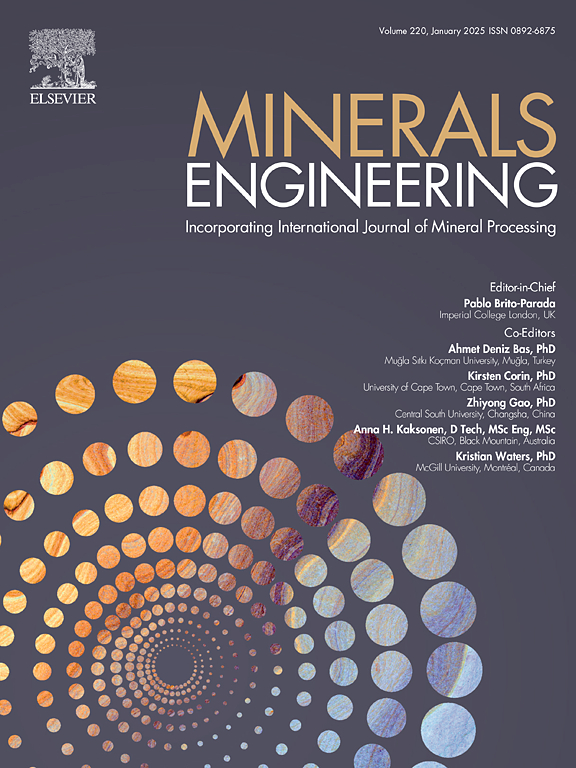The process analysis of converting ferronickel into high nickel matte
IF 4.9
2区 工程技术
Q1 ENGINEERING, CHEMICAL
引用次数: 0
Abstract
Sulfurization smelting is a effective process for the transformation of ferronickel into low nickel matte, with subsequent conversion through oxygen blowing and converting enabling the production of high nickel matte. This study involved the initial mixing and smelting of ferronickel, SiO2, pyrite, and coke, followed by the blending of the resulting low nickel matte with SiO2 during oxygen blowing at elevated temperatures, with an emphasis on optimizing both stages of the process. The research revealed that in the first stage, when 50 g of pyrite, 27 g of SiO2, and 3 g of coke were added, and the smelting was carried out at a temperature of 1425℃ for 2.5 h, over 99 % of the nickel was successfully converted from ferronickel into low nickel matte, with a nickel content exceeding 35 % and sulfur content of around 17 %, while the slag nickel content was as low as 0.4 %. In the second stage, with a conversion time of 8 h, 23 g of SiO2 addition, and a converting temperature of 1300℃, over 96 % of the nickel was transformed into high-grade matte with a nickel content exceeding 75 % and sulfur content of 18 %. These findings provide valuable insights for the utilization of ferronickel in the production of nickel sulfate to meet the demands of the burgeoning lithium battery industry.
镍铁转化为高镍锍的工艺分析
硫化冶炼是将镍铁转化为低镍锍的有效工艺,再经吹氧转化,生产高镍锍。本研究包括镍铁、SiO2、黄铁矿和焦炭的初始混合和熔炼,然后在高温吹氧过程中将得到的低镍哑光与SiO2混合,重点是优化这两个阶段的工艺。研究表明,在第一阶段,加入50 g黄铁矿、27 g SiO2、3 g焦炭,在1425℃的温度下熔炼2.5 h, 99%以上的镍成功从镍铁转化为低镍锍,镍含量超过35%,硫含量约为17%,渣镍含量低至0.4%。在第二阶段,转化时间为8 h, SiO2添加量为23 g,转化温度为1300℃,96%以上的镍转化为镍含量超过75%,硫含量达到18%的优质哑光。这些发现为利用镍铁生产硫酸镍以满足蓬勃发展的锂电池工业的需求提供了有价值的见解。
本文章由计算机程序翻译,如有差异,请以英文原文为准。
求助全文
约1分钟内获得全文
求助全文
来源期刊

Minerals Engineering
工程技术-工程:化工
CiteScore
8.70
自引率
18.80%
发文量
519
审稿时长
81 days
期刊介绍:
The purpose of the journal is to provide for the rapid publication of topical papers featuring the latest developments in the allied fields of mineral processing and extractive metallurgy. Its wide ranging coverage of research and practical (operating) topics includes physical separation methods, such as comminution, flotation concentration and dewatering, chemical methods such as bio-, hydro-, and electro-metallurgy, analytical techniques, process control, simulation and instrumentation, and mineralogical aspects of processing. Environmental issues, particularly those pertaining to sustainable development, will also be strongly covered.
 求助内容:
求助内容: 应助结果提醒方式:
应助结果提醒方式:


